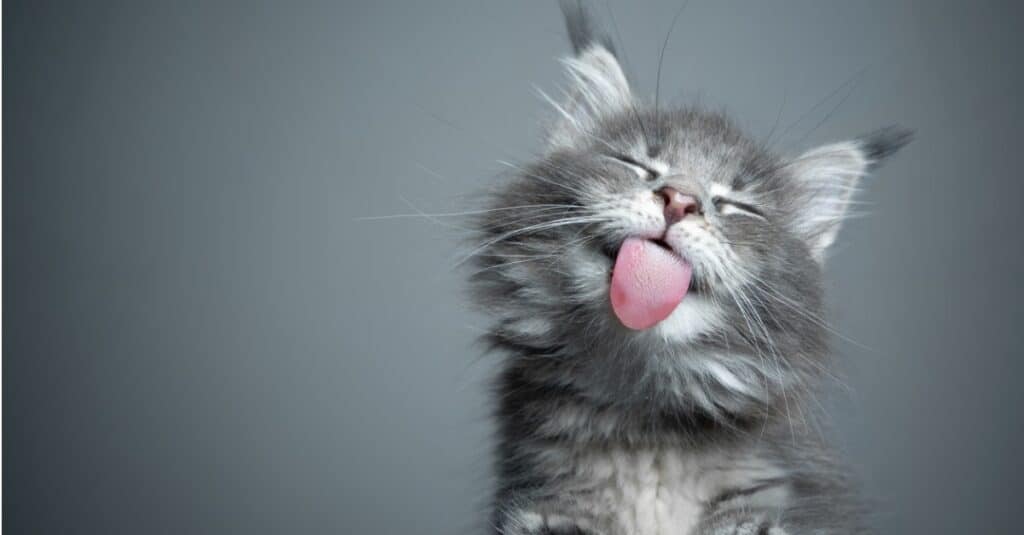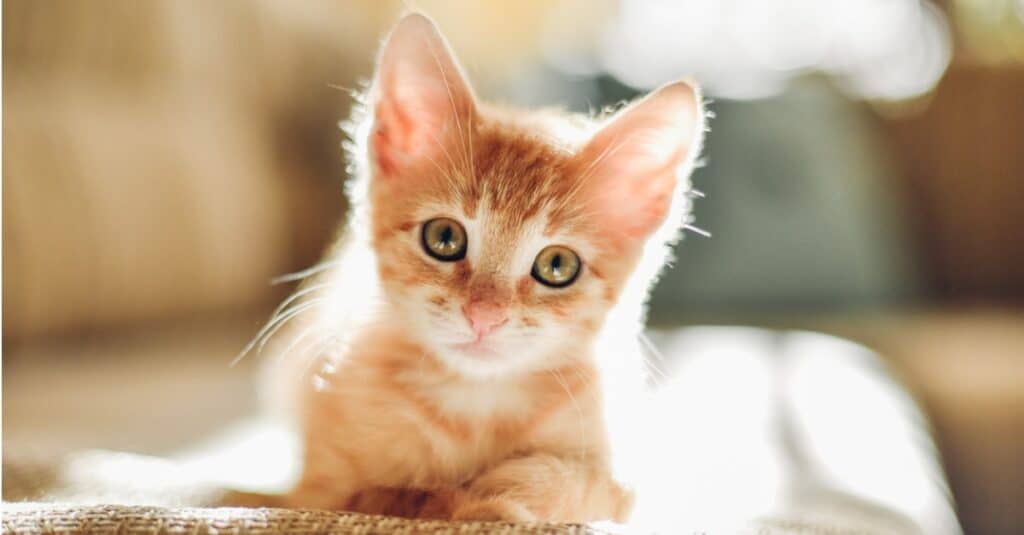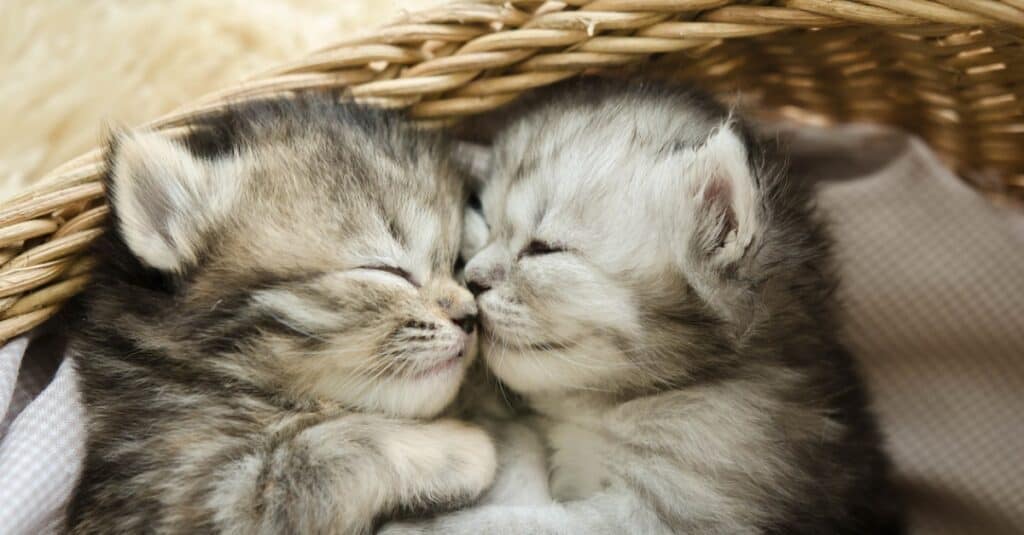Baby cats are well-known for their playful, energetic demeanors. They make adorable pets and are widely loved for their independent and sometimes mischievous behavior. But did you know that kittens feed on the same teat each time they eat or that they don’t all like catnip? Keep reading to learn five amazing facts about kittens and look at some adorable baby cat pictures.
#1: A Wild Monkey Adopted a Baby Cat!

A kitten in Bali was adopted by a monkey!
©iStock.com/Nils Jacobi
Chances are, you’ve heard a few stories about unlikely duos in the animal kingdom. When you think of a baby cat, you probably imagine a domesticated house animal. But one tiny cat ended up in an unlikely environment where he now calls home.
A wild long-tailed macaque in Ubud, Bali, adopted a tiny kitten when it was abandoned in the forest! The monkey carefully took care of the kitten and introduced it to other members of his family. He also cuddled, carried, and protected the tiny feline.
#2: Kitten Siblings Can Have Multiple Fathers

Multiple tomcats can be responsible for a single litter of kittens!
©iStock.com/RalchevDesign
When adult cats are ready to mate, they go into something called a heat cycle. During a heat cycle, the female cat calls out of a tomcat to mate with her. Cats are induced ovulators. This means that when they engage in the act of mating, their bodies automatically release eggs.
However, most cats must mate more than once to ovulate successfully. In some cases, it can take up to three or four tries before an egg is successfully released. This means that for the 1-4 days a cat is in heat, she will mate multiple times, potentially with numerous different males.
Cats can also ovulate multiple times in a heat cycle. Consequently, some eggs might be fertilized by different fathers. Ultimately, this means that a single litter of baby cats can trace back to more than one biological father. This is a phenomenon called superfecundity.
#3: Kittens Feed On the Same Teat Every Time

Kittens are familiar with the smell of the teat they nurse from.
©iStock.com/bozhdb
Baby cats are mammals, which means that they survive solely on their mother’s milk for the first six to eight weeks of their lives. They consume their mother’s milk by latching onto teats on the stomach of the adult female cat. Cats have eight teats to be able to accommodate feeding each of their kittens simultaneously.
But did you know that kittens feed off of the same teat every time they go to feed? It’s true! But how do they know the difference? The answer is amazing: they use their smell. More specifically, each of an adult cat’s teats has a specific smell.
Kittens memorize the smell of their teat and return to feed on the same one each time they get hungry. When they go to feed from their mother’s teat, kittens use their paws to knead her stomach, which stimulates the flow of milk. When the kittens grow up, they knead their owners when they are nurtured because it triggers the same response.
#4: Not All Baby Cats Like Catnip

One-third of cats lack the gene that causes a response to catnip.
©iStock.com/FamVeld
Catnip is a plant in the mint family that some cats respond to. However, not all cats have a response to catnip. The plant stimulates cats when smelled or eaten. When smelled, it causes cats to roll around in it, rub against the plant, and salivate. When consumed, it has a calming effect.
Whether or not a baby cat responds to catnip depends on their genes. The autosomal gene for responding to catnip is passed down to kittens from their mothers. However, newborn kittens don’t care for catnip.
When under three months old, kittens won’t respond to catnip at all. In fact, they may even display an aversion for the plant. You can usually tell whether or not your tiny feline friend will like catnip once they reach about four months old. About one-third of cats don’t like catnip when they reach adulthood.
#5: All Kittens are Born with Blue Eyes

Kittens are born with blue eyes due to a lack of melanin in their body as newborns.
©iStock.com/anurakpong
What could be sweeter than a tiny baby cat with blue eyes? For the first seven to ten days of their lives outside the womb, kittens have their eyes shut. Once they open, beautiful blue eyes are revealed. However, this eye color only remains for about the first month of a kitten’s life.
Even though every kittens’ eyes might appear blue, it is an optical illusion. In reality, kittens’ eyes have no pigment and it’s just the light reflecting off of them that causes them to appear blue. At around a month old, their bodies begin to produce melanin, the pigment responsible for determining their eye color. Baby lions are also born with “blue” eyes as well.
Here’s another fun fact: kittens’ eye color is genetically linked to the color of their coat. Cats typically have blue, green, yellow, or brown eyes. Mostly white cats generally have gold, blue, green, or copper eyes. On the other hand, cats with dark-colored fur most commonly have greenish-yellow or gold eyes.
Some cats, like the Tonkinese breed, always have blue eyes. Eye color is wholly determined by a cat’s DNA.
The photo featured at the top of this post is © iStock.com/anurakpong
FAQs (Frequently Asked Questions)
How much do baby cats weigh?
Newborn baby cats typically weigh anywhere from one to five ounces.
What do baby cats eat?
Cats are mammals, which means they survive primarily on their mother’s milk as newborns. After the first six to eight weeks, baby cats transition to hard kibble or wet food.
What are baby cats called?
A single baby cat is called a kitten. A litter of baby cats is called a caboodle or a kindle.
Thank you for reading! Have some feedback for us? Contact the AZ Animals editorial team.







